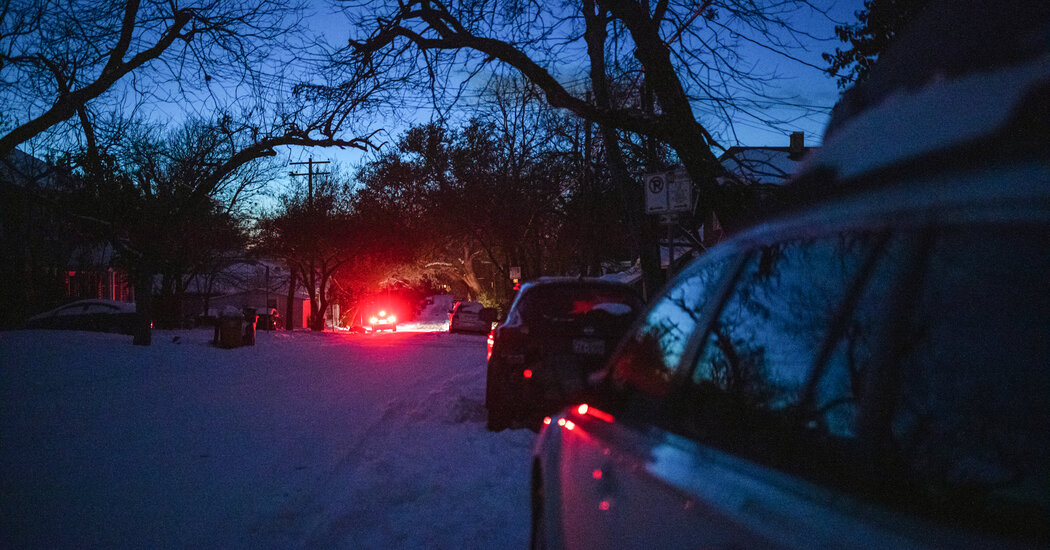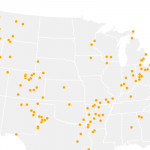
Brad Plumer and
A record-breaking winter storm has devastated Texas this week, crippling the state’s electric grid and triggering rolling blackouts that have left millions of Texans without power amid dangerously cold temperatures.
So what does this have to do with climate change? First, some scientists are now exploring whether warming temperatures in the Arctic might, paradoxically, be helping to fuel powerful winter storms in the United States. This is still an area of intense scientific debate, but it’s one worth watching.
Whether or not global warming helped cause this week’s winter storm, there’s a broader lesson there. One of the hardest things about dealing with climate change is that our modern infrastructure was built with historical weather conditions in mind. But, of course, those conditions are now changing rapidly, and the past is no longer a good guide to the future. Dealing with never-before-seen weather events is going to be one of the major challenges of our time.
As we reported this week on the grid breakdowns in Texas, one thing we heard repeatedly was that they stemmed, in part, from a failure of planning. Texas had never experienced winter weather quite this severe, at least not in modern memory, and the state’s power system was ill-prepared to deal with the frigid conditions.
Quotable: “No one’s model of the power system envisioned that all 254 Texas counties would come under a winter storm warning at the same time,” said Joshua Rhodes, an expert on the state’s electric grid at the University of Texas, Austin.
Why it matters: The electric grid is one of the most crucial pieces of modern infrastructure, and power systems all over the country face serious risks from a changing climate.
Another effect of the winter storm
Time and time again, climate-related disasters have highlighted underlying economic, social and racial inequities in the United States, and beyond.
“Whether it’s flooding from severe weather events like hurricanes or it’s something like this severe cold, the history of our response to disasters is that these communities are hit first and have to suffer the longest,” Robert Bullard, a professor at Texas Southern University and an expert on wealth and racial disparities related to the environment, says in our article on how the freezing weather and its aftermath are affecting the most vulnerable.
Here are three ways the widespread power outages in Texas are affecting historically marginalized communities:
Rising energy prices amid surging demand could leave many families unable to pay their utility bills and risk power shut-offs at a time when they are most at risk.
Air pollution from industrial sites tend to be located closer to lower-income, minority communities and often release bursts of pollutants into the air when they shut down and again when they restart.
The homeless are among the most at risk. In San Antonio, church organizations are setting up tent cities to provide temporary shelter from the weather.
One more thing:
Want to see just how far-reaching the storm was — and its impact on the grid? We have maps.
7 years tracking Arctic survivors
I’ll be honest about it —- a couple of weeks ago I knew nothing about wolverines, other than that they were the nickname of the University of Michigan football team.
But when photographer Peter Mather pitched us his incredible photographs of these Arctic animals, we knew we had to learn more. I called Tom Glass, the wolverine researcher at the University of Alaska Fairbanks whom Mr. Mather had accompanied over several winters in the Arctic, and he filled me in. Mr. Glass and other researchers have trapped and tracked wolverines to learn about their lives in a region that is rapidly changing as the planet warms.
Wolverines, it turns out, are remarkable animals, solitary and strong, with the stamina to travel for miles across the snowy tundra (close to 40 miles in one case logged by Mr. Glass) in pursuit of prey. They weigh less than 50 pounds, but can kill a caribou that weighs 250.
Wolverines have an unusual relationship with Arctic wolves. On the one hand, the wolves are their main predator. On the other hand, wolves inadvertently help keep them alive.
One of Mr. Mather’s photographs shows a wolverine with a caribou carcass on a rocky slope in the Brooks Range. A wolf had killed the animal — most likely by chasing it off a precipice — but after a day or so had eaten about all it could and moved on. The wolverine had come across it and, with much stronger jaws to tear the flesh, could feast on it for days. Wolverines rely on scavenging like this for much of their food.
Mr. Mather’s photographs offer a rare look at these animals in their snowy habitat. Take a look at them here. — Henry Fountain
Regular readers will know that Climate Fwd: often includes one thing you can do to reduce your contribution to global warming. But addressing climate change means more than just curbing greenhouse gas emissions; it also requires finding new ways to cope with the consequences of climate change that are already happening, and getting worse.
So today, we offer one thing you can do to protect yourself against climate change: Think hard about buying flood insurance.
If you have a home mortgage in a flood zone, you probably had to sign up for flood insurance when you bought your house. But for everyone else, it’s an optional addition to their homeowners’ or renters’ insurance policy — and one that only a tiny minority of Americans opt for.
According to federal data, just 4.8 million homes carry flood insurance through the National Flood Insurance Program, the taxpayer-subsidized plan that provides almost all flood policies around the country. But at least 7.8 million homes are at risk, and potentially millions more, according to data released by the First Street Foundation, a group that last year released a tool for measuring a property’s flood risk.
Flood insurance isn’t cheap. The median cost for a single-family home is $541 a year, according to the Federal Emergency Management Agency, which runs the insurance program. And if you’re in a flood zone, it’s $797. (For renters, who buy policies to cover just their belongings against flooding, the median nationwide cost is lower, at $346 a year.)
But compare that against what could happen if you don’t buy it: Tremendous damage to your home, and no way to pay for it.
Many Americans mistakenly think that if their home is damaged or destroyed by flooding, FEMA will help repair it even if they’re not insured, said Roy Wright, who ran the flood insurance program until 2018. After Hurricane Harvey hit Houston in 2017, for example, the average payout in emergency disaster assistance was about $3,000, compared with more than $117,000 for people with flood insurance.
“Peace of mind costs a few hundred dollars,” said Mr. Wright, who now runs the Insurance Institute for Business & Home Safety, a research group. “You should take every effort to find the money.” — Christopher Flavelle
This newsletter is free, but you can go deeper into the articles we highlight each week with a subscription to The Times. Please consider becoming a subscriber today.
If you’re not getting Climate Fwd: in your inbox, you can sign up here
We’d love your feedback on the newsletter. We read every message, and reply to many! Please email thoughts and suggestions to climateteam@nytimes.com.

Average Rating